History of Gujarat
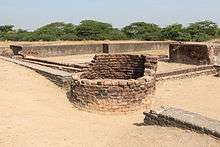
| History of Gujarat | ||||||||||||||||||||||||||||||||
|---|---|---|---|---|---|---|---|---|---|---|---|---|---|---|---|---|---|---|---|---|---|---|---|---|---|---|---|---|---|---|---|---|
|
Before 3000 BC
|
||||||||||||||||||||||||||||||||
|
Bronze Age (3000–1300 BC)
|
||||||||||||||||||||||||||||||||
|
Iron Age (1500–300 BC)
|
||||||||||||||||||||||||||||||||
|
Classical Period (380 BC–AD 1206)
|
||||||||||||||||||||||||||||||||
|
Medieval and Early Modern Periods (1299–1819)
|
||||||||||||||||||||||||||||||||
|
Colonial period (1819–1961)
|
||||||||||||||||||||||||||||||||
|
Post-independence (1947–)
|
||||||||||||||||||||||||||||||||
The history of Gujarat, began with settlements of the Indus Valley Civilisation that have been found in the region. With the discovery of large Harappan site of Dholavira in Kutch District, the history of Gujarat dates back to 5000 BC. Lothal (early Harappan town dating back to 3000 BC) has been established as the oldest known port of the world. Gujarat's coastal cities, chiefly Bharuch, served as ports and trading centers in the Nanda, Maurya, Satavahana and Gupta empires as well as Western Kshatrapas period. After the fall of the Gupta empire in the 6th century, Gujarat flourished as an independent Hindu/Buddhist states. The Maitraka dynasty, descended from a Gupta general, ruled from the 6th to the 8th centuries from their capital at Vallabhi, although they were ruled briefly by Harsha during the 7th century. The Arab rulers of Sindh sacked Vallabhi in 770, bringing the Maitraka dynasty to an end. The Gurjara-Pratihara Empire ruled Gujarat after from the 8th to 10th centuries. As well as, for some periods the region came under the control of Rashtrakuta Empire and Pala Empire. In 775 the first Parsi (Zoroastrian) refugees arrived in Gujarat from Greater Iran.[1]
During the 10th century, the native Solanki dynasty came to power. Under the Solanki dynasty, Gujarat reached to its greatest extent. From 1297 to 1300, Allauddin Khilji, the Turkic Sultan of Delhi, destroyed Anhilwara and incorporated Gujarat into the Delhi Sultanate. After Timur's sacking of Delhi at the end of the 14th century weakened the Sultanate, Gujarat's Rajput Muslim governor Zafar Khan Muzaffar asserted his independence, and his son, Sultan Ahmed Shah (ruled 1411 to 1442), restructured Ahmedabad as the capital. Cambay eclipsed Bharuch as Gujarat's most important trade port. The Sultanate of Gujarat remained independent until 1576, when the Mughal emperor Akbar the Great conquered it and annexed it to the Mughal Empire. The port of Surat become the prominent and main port of India during Mughal rule. Gujarat remained a province of the Mughal empire until the Marathas occupied eastern and central Gujarat in the 18th century; Western Gujarat (Kathiawar and Kutch) were divided among numerous local rulers.
Later in the 18th century, Gujarat came under control of the Maratha Empire who dominated the politics of India. Pilaji Gaekwad, first ruler of Gaekwad dynasty, established the control over Baroda and much of Gujarat. After the Battle of Panipat in 1761, all Maratha generals established themselves as an autonomous government while keeping the nominal authority of the Peshwas of Pune and the Chhatrapati in Satara. The British East India Company wrested control of much of Gujarat from the Marathas during the Second Anglo-Maratha War. Many local rulers, notably the Maratha Gaekwads of Baroda (Vadodara), made a separate peace with the British and acknowledged British sovereignty in return for retaining local self-rule. Gujarat was placed under the political authority of the Bombay Presidency, with the exception of Baroda state, which had a direct relationship with the Governor-General of India. From 1818 to 1947, most of present-day Gujarat, including Kathiawar, Kutch, and northern and eastern Gujarat were divided into hundreds of princely states, but several districts in central and southern Gujarat, namely Ahmedabad, Broach (Bharuch), Kaira (Kheda), Panchmahal, and Surat, were ruled directly by British officials. Mohandas Gandhi, considered India's "father of the nation", was a Gujarati who led the Indian Independence Movement against the British colonial rule.[2] Gujarat was formed by splitting Bombay state in 1960 on linguistic lines. From 1960 to 1995, Indian National Congress retained power in Gujarat Legislative Assembly while other political parties ruled for incomplete terms in the 1970s and 1990. Bharatiya Janata Party has been in the power since 1998.
Prehistoric times
Several sites of stone age are discovered in riverbeds of Sabarmati, Mahi river and lower Narmada rivers of Gujarat.[3] Some of such sites are Hirpura, Derol, Kapadvanj, Langhnaj and Shamlaji.[4]
Indus Valley Civilization
The history of modern human settlement began with settlements of the Indus Valley Civilisation that have been found in the region. With the discovery of large Harappan site of Dholavira in Kutch District, the history of Gujarat dates back to 5000 BC. Lothal (early Harappan town dating back to 3000 BC) has been established as the oldest known port of the world.
Ancient Period
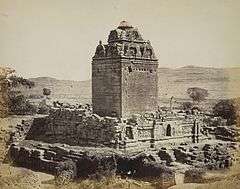
.jpg)
The early history of Gujarat is full of imperial grandeur of Chandragupta Maurya who conquered a number of earlier states of Gujarat. Pushyagupta, a Vaishya, was appointed Governor of Saurashtra by the Mauryan regime. He ruled (322 BC to 294 BC) Giringer (present Junagadh) and built a dam on the Sudarshan lake. Emperor Ashoka, the grandson of Chandragupta Maurya, not only ordered engraving of his famous edicts on the rock at Junagadh, but asked his Governor Tusherpha to take out canals from the lake where an earlier Mauryan Governor had built a dam. Between the decline of the Mauryan power and Saurashtra coming under the sway of Samprati Mauryas of Ujjain, there was a Greek incursion into Gujarat led by Demetrius.In the first half of the first century A.D. there is the story of a merchant of King Gondaphares landing in Gujarat with Apostle Thomas.The incident of the cup-bearer killed by a LION might indicate that the port city described is in Gujarat.[5][6]
For nearly 300 years from the start of the 1st century AD, Saka rulers played prominent part in Gujarat's history. Weather beaten rock at Junagadh gives a glimpse of the Ruler Rudradaman I (100 AD) of the Saka satraps known as Western Satraps, or Kshatraps. Mahakshatrap Rudradaman I founded the Kardamaka dynasty which ruled from Anupa on the banks of the Narmada up to Aparanta region which bordered Punjab. In Gujarat several battles were fought between the south Indian Satavahana dynasty and the Western Satraps. The greatest ruler of the Satavahana Dynasty was Gautamiputra Satakarni who defeated the Western Satraps and conquered some parts of Gujarat in the 2nd century CE[7]
The Kshatrapa dynasty was replaced by the Gupta reign with the conquest of Gujarat by Chandragupta Vikramaditya. Vikramaditya's successor Skandagupta has left an inscription (450 AD) on a rock at Junagadh which gives details of the repairs of the embankment, damaged by floods, of Sudarshan lake by his Governor. Anarta and Saurashtra regions were both part of the Gupta empire. Towards the middle of the 5th century the Gupta empire started to decline. Senapati Bhatarka, the Maitraka general of the Guptas, took advantage of the situation and in 470 AD he set up what came to be known as the Maitraka state. He shifted his capital from Giringer to Valabhipur, near Bhavnagar, on Saurashtra's east coast. Maitrakas of Vallabhi became very powerful and their rule prevailed over large parts of Gujarat and even over adjoining Malwa. Maitrakas set up a university which came to be known far and wide for its scholastic pursuits and was compared with the famous Nalanda university. It was during the rule of Dhruvasena Maitrak that Chinese philosopher-traveler Xuanzang visited in 640 AD.
Rajput Period
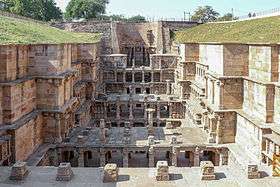

In the early 8th century some parts of Gujarat was ruled by the south Indian Chalukya dynasty. In the early 8th century the Arabs of the Umayyad Caliphate established an Empire which stretched from Spain in the west to Afghanistan and Pakistan in the east. The Arab rulers tried to expand their Empire in the 8th century and invaded Gujarat but the Arab invaders were defeated by the south Indian general Pulakesi who was sent by the south Indian Emperor Vikramaditya II of the Chalukya Dynasty. After this victory the Arab invaders were driven out of Gujarat. Pulakesi received the title Avanijanashraya (refuge of the people of the earth) by Vikramaditya II for the protection of Gujarat. In the late 8th century the Kannauj Triangle period started. The 3 major Indian Dynasties the northwest Indian Gurjara-Pratihara Dynasty, the south Indian Rashtrakuta Dynasty and the east Indian Pala Empire dominated India from the 8th to 10th century. During this period the northern part of Gujarat was ruled by the north Indian Gurjara-Pratihara Dynasty and the southern part of Gujarat was ruled by the south Indian Rashtrakuta Dynasty.[8] Southern Gujarat was ruled by the south Indian Rashtrakuta dynasty until it was captured by the south Indian ruler Tailapa II of the Western Chalukya Empire.[9]
The Solanki dynasty [10] ruled Gujarat from c. 960 to 1243. Gujarat was a major center of Indian Ocean trade, and their capital at Anhilwara (Patan) was one of the largest cities in India, with population estimated at 100,000 in the year 1000. In 1026, the famous Somnath temple in Gujarat was destroyed by Mahmud of Ghazni. After 1243, the Solankis lost control of Gujarat to their feudatories, of whom the Vaghela chiefs of Dholka came to dominate Gujarat. In 1292 the Vaghelas became tributaries of the Yadava dynasty of Devagiri in the Deccan. Karandev of the Vaghela dynasty was the last Hindu ruler of Gujarat. He was defeated and overthrown by the superior forces of Allauddin Khilji from Delhi in 1297. With his defeat Gujarat not only became part of the Muslim empire but the Rajput hold over Gujarat lost for ever.
Muslim Period
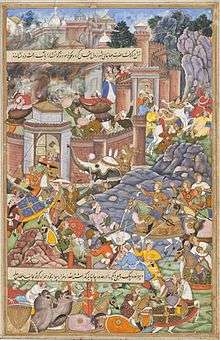
Before they finally entrenched themselves in 1298, the Muslims had only an occasional contact with this part of India. This was either as sea-farers or traders. They were allowed to establish two small settlements in Cambay (current Khambhat) and Broach (current Bharuch). Abdulla, a missionary from Egypt, who came during Sidhraj Jaysinh's regime and was allowed to preach, is credited with the formation of the Bohra community among the Muslims. However, after the defeat of Karandev Vaghela at the hands of Allauddin Khilji, Muslim rule continued for nearly 400 years either under Delhi's viceroyalty or under Muslim Sultanates till the Mughal viceroy, Monimnkhan was defeated by the Marathas who captured Ahmedabad in 1758.
Zafar Shah, a viceroy of Delhi for Gujarat, was responsible for starting the Sultanate of Gujarat. He fully exploited then prevailing conditions in Delhi to his advantage. He shook off his loyalty to the emperor, declared independence and became the first Sultan. He assumed the title of Muzaffar Shah. His successor Ahmed Shah founded a new city, following a dream, on the banks of the River Sabarmati and named it Ahmedabad after his own name. Since then, this new city became the capital of successive regimes in Gujarat until the state of Gujarat was formed in 1960 and the capital was moved to new city of Gandhinagar later. Ahmedabad grew into a flourishing city.
Mahmud Shah succeeded Ahmed Shah, Mahmud became a powerful ruler and was successful in over powering and subduing most of the Rajput chieftains. As a conqueror Mahmud was ruthless, as an administrator efficient and as a builder a great one. Apart from subduing the Rajput chieftains, Mahmud also tried to remove the Portuguese menace with the help of a naval fleet raised by his slave named Malik Ayyaz. But he was unsuccessful and they set up a powerful naval base at Diu off the Sautrashtra coast.
Under Mahmud Shah, Gujarat once again became prosperous and there was a great deal of progress and state-building activity. Patan, the ancient seat of Hindu learning, once again became a seat of learning in Islamic disciplines. The available infrastructure at Patan was exploited by Mahmud Shah. The decline of the Sultanate started with the assassination of Sikandar Shah. Because of this decline, Gujarat became an easy prey to the great Mughal Emperor Akbar's armies. Bahadur Shah, the last Sultan, was defeated which marked the beginning of the Mughal rule which lasted almost 200 years.
Notwithstanding the fact that Gujarat became a part of the Mughal Empire its importance did not diminish as is apparent from the selection of the ablest princes as Gujarat's viceroys. Murad Baksh, Shah Jahan, Dara Shikoh, Aurangzeb, Muhammad Azam Shah among others, were all made the Viceroys of this West coast region. The formal Muslim rule in Gujarat ended in 1758 when Momin Khan surrendered to the Marathas, however the Islamic influence remained.
Early Modern Period
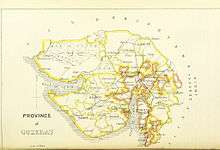
Maratha Empire
When the cracks had started to develop in the edifice of the Mughal empire in the mid-17th century, the Marathas were consolidating their power in the west, Chatrapati Shivaji, the great Maratha ruler, attacked Muslim merchants in Surat twice first in 1664 and again in 1672. These attacks marked the entry of the Marathas into Gujarat. However, before the Maratha inroads into Gujarat, the Europeans had made their presence felt, with the Portuguese leading them, followed by the Dutch and the English.
The Peshwas had established their sovereignty over Gujarat including Saurashtra, and collected taxes and tributes through their representatives. Damaji Gaekwad and Kadam Bande divided the Peshwa's territory between them, with Damaji establishing the sway of Gaekwad over Gujarat and made Baroda (present day Vadodara) his capital. The ensuing internecine war among the Marathas were fully exploited by the British, who interfered in the affairs of both Gaekwads and the Peshwas.
The British also embarked upon their policy of Subsidiary Alliance. With this policy they established their paramountcy over one princely state after another. Anandrao Gaekwad joined the Alliance in 1802 and surrendered Surat and adjoining territories to the British. In the garb of helping the Marathas, the British helped themselves, and gradually the Marathas' power came to an end, in 1819 in Gujarat. Gaekwad and other big and small rulers accepted the British Paramountcy.
European Colonial Rule
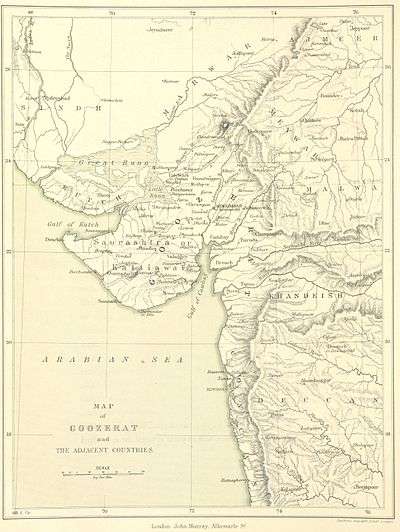

Portugal was the first European power to arrive in Gujarat, acquiring several enclaves along the Gujarati coast, including Daman and Diu and Dadra and Nagar Haveli. The British East India Company Gujarat was placed under the political authority of Bombay Presidency, with the exception of Baroda state, which had a direct relationship with the Governor-General of India. From 1818 to 1947, most of present-day Gujarat, including Kathiawar, Kutch, and northern and eastern Gujarat were divided into dozens of princely states, but several districts in central and southern Gujarat, namely Ahmedabad, Broach (Bharuch), Kaira, Panch Mahals, and Surat, were ruled directly by British officials.
Indian Independence Movement
The people of Gujarat were the most enthusiastic participants in India's struggle for freedom. Leaders like Mahatma Gandhi, Sardar Vallabhbhai Patel, Morarji Desai, K.M. Munshi, Narhari Parikh, Mahadev Desai, Mohanlal Pandya and Ravi Shankar Vyas all hailed from Gujarat. It was also the site of the most popular revolts, including the Satyagrahas in Kheda, Bardoli, Borsad and the Salt Satyagraha.
See Also: Freedom fighters from Gujarat There is
1947–1960


After Indian independence and the Partition of India in 1947, the new Indian government grouped the former princely states of Gujarat into three larger units; Saurashtra, which included the former princely states on the Kathiawar peninsula, Kutch, and Bombay state, which included the former British districts of Bombay Presidency together with most of Baroda state and the other former princely states of eastern Gujarat. In 1956, Bombay state was enlarged to include Kutch, Saurashtra, and parts of Hyderabad state and Madhya Pradesh in central India. The new state had a mostly Gujarati-speaking north and a Marathi-speaking south. Mahagujarat Movement led by Indulal Yagnik demanded splitting of Bombay state on linguistic lines. On 1 May 1960, Bombay state bifurcated into Gujarat and Maharashtra. The capital of Gujarat was Ahmedabad.
Kutch was hit by the earthquake in 1956 which destroyed major parts of Anjar town. Gandhidham, Sardarnagar and Kubernagar were refugee settlements established for the resettlement of Sindhi Hindu refugees arriving from Pakistan after partition.
1960–1973
Members of legislative assembly were elected from 132 constituencies of newly formed Gujarat state. Indian National Congress (INC) won the majority and Jivraj Narayan Mehta became the first chief minister of Gujarat. He served until 1963. Balwantrai Mehta succeed him. During Indo-Pakistani War of 1965, Mehta flew on aircraft to inspect Kutch border between India and Pakistan. The aircraft was shot down by Pakistan Air Force. Mehta was killed in the crash.[11][12] Hitendra Kanaiyalal Desai succeeded him and won assembly elections. In 1969, Indian National Congress split into Congress (O) headed by Morarji Desai and Congress (I) headed by Indira Gandhi.[13] At the same time, the Hindu nationalist organization Rashtriya Swayamsevak Sangh (RSS) had established itself deeply in Gujarat around this period. The riots broke out across Gujarat in September to October 1969, resulting in large number of casualties and damage to properties. Desai resigned in 1971 due to split of INC and President's rule was imposed in Gujarat. Later Ghanshyam Oza became chief minister when Indira Gandhi led Congress (I) won majority in parliament after 1971 Indo-Pakistani war. Chimanbhai Patel opposed Oza and became chief minister in 1972. The capital of Gujarat moved from Ahmedabad to Gandhinagar in 1971 but legislative assembly building was completed in 1982.[14]
1974–1980
Navnirman movement started in December 1973 due to price rise and corruption in public life. People demanded resignation of Patel.[15][16][17][18] Due to pressure of protests, Indira Gandhi asked Patel to step down. He resigned on February 9, 1974 and President's rule imposed.[15][17] The governor suspended the state assembly and President's rule was imposed. Opposition parties led stepped in with demand for dissolution of state assembly.[16]Congress had 140 out of 167 MLAs in state assembly. 15 Congress (O) and three Jan Sangh MLAs also resigned. By March, protesters had got 95 of 167 to resign. Morarji Desai, leader of Congress (O), went on an indefinite fast in March and the assembly was dissolved bringing end to agitation.[15][16][17] No fresh election held until Morarji Desai went on indefinite hunger strike in April 1975.[16] The fresh elections were held in June 1975. Chimanbhai Patel formed new party named Kisan Mazdoor Lok Paksh and contested on his own. Congress lost elections which won only 75 seats. Coalition of Congress (O), Jan Sangh, PSP and Lok Dal known as Janata Morcha won 88 seats and Babubhai J. Patel became Chief Minister. Indira Gandhi imposed the emergency in 1975.[16] Janata Morcha government lasted nine months and president's rule imposed in March, 1976 following failure of passage of budget in assembly to opposition of coalition partners.[17] Later Congress won elections in December 1976 and Madhav Singh Solanki became Chief Minister.[16][17] A year later Solanki resigned and again Babubhai Patel led Janata Party formed the government. He shifted his cabinet to Morbi for six months during 1979 Machchhu dam failure disaster which resulted in large casualties.[19]
1980–1995
Janata Morcha government was dismissed and president's rule was imposed in 1980 even though it had majority. Later Madhavsinh Solanki led INC won the election in 1980 and formed the government which completed five years in office. Amarsinh Chaudhary succeeded him in 1985 and headed government till 1989. Solanki again became chief minister until INC lost in 1990 election following Mandal commission protests. Chimanbhai Patel came back to power in March 1990 as the head of a Janata Dal -Bharatiya Janata Party coalition government. Coalition broke just few months after in October 1990 but Chimanbhai Patel managed to retain majority with support of 34 INC legislatures. Later Patel joined the INC and continued till his death in February 1994. Chhabildas Mehta succeeded him and continued till March 1995. In 1994 plague endemic broke out in Surat resulting in 52 deaths.[20]
1995–2000
Following the rise of Bharatiya Janata Party (BJP) at centre, Keshubhai Patel led BJP won in 1995 assembly election. Keshubhai Patel became the chief minister of Gujarat in March but resigned eight months later as his colleague Shankersinh Vaghela revolted against him. BJP was split as Rashtriya Janata Party was formed by Vaghela who became the Chief Minister by support of INC. Assembly was dissolved in 1998 as INC withdrew its support. BJP returned to power led by Patel in 1998 assembly elections and he became the chief minister again.[21] In 1998, a severe tropical cyclone hit Kandla port and Saurashtra and Kutch regions.[22]
2000–present
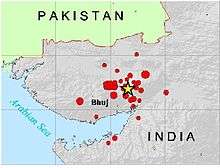
Gujarat was hit with a devastating earthquake on 26 January 2001 which claimed a staggering 20,000 lives, injured another 200,000 people and severely affected the lives of 40 million of the population. Patel resigned as chief minister in October 2001 due to his failing health. Allegations of abuse of power, corruption and poor administration; as well as a loss of BJP seats in by-elections and mismanagement of relief works during the aftermath of the 2001 Bhuj earthquake; prompted the BJP's national leadership to seek a new candidate for the office of chief minister. He was replaced by Narendra Modi.[23][24][25] In February 2002, Godhra train burning triggered statewide riots which resulted in large number of casualties and economic loss.[26] In September 2002, there was a terrorist attack on Akshardham temple complex at Gandhinagar.[27] Modi led BJP won December 2002 election with majority.
In 2005 and 2006, Gujarat was affected by floods. In July 2008, a series of 21 bomb blasts hit Ahmedabad, within a span of 70 minutes. 56 people were killed and over 200 people were injured in the attack.[28][29][30] 2009 Gujarat hepatitis outbreak resulted in 49 deaths. In July 2009, more than 130 people died in hooch tragedy.[31]
Narendra Modi led BJP retained power in 2007 and 2012 assembly elections. Anandiben Patel became the first women Chief Minister of Gujarat on May 22, 2014 as Narendra Modi left the position following win in Indian general election, 2014.[32] He sworn in as the second Prime Minister of Gujarati origin after Morarji Desai in May 2014. Heavy rain in June and July 2015 resulted in widespread flooding in Saurashtra and north Gujarat resulting in more than 150 deaths. The wild life of Gir Forest National Park and adjoining area was also affected.[33][34][35] Starting July 2015, the people of Patidar community carried out demonstrations across the state seeking Other Backward Class status which turned violent on 25 August and 19 September 2015 for brief period.[36] The agitation continued and again turned violent in April 2016.[37]
References
- ↑ Official Gujarat State Portal. "History of Gujarat".
Gujarat : The State took its name from the Gujara, the land of the Gujjars, who ruled the area during the 700's and 800's.
- ↑ "Modern Gujarat". Mapsofindia.com. Retrieved 16 July 2010.
- ↑ Frederick Everard Zeuner (1950). Stone Age and Pleistocene Chronology in Gujarat. Deccan College, Postgraduate and Research Institute.
- ↑ Malik, S. C. (1966). "The Late Stone Age Industries from Excavated Sites in Gujarat, India". Artibus Asiae. JSTOR. 28 (2/3): 162. doi:10.2307/3249352. Retrieved 23 September 2016.
- ↑ The Acts of Judas Thomas, M.R.James,Tr.by M. R. James, Oxford: Clarendon Press, 1924.
- ↑ A.E. MEDLYCOTT: INDIA AND THE APOSTLE THOMAS. http://www.indianchristianity.com/html/chap4/chapter4a.htm
- ↑ Trade And Trade Routes In Ancient India von Moti Chandra page: 99
- ↑ Ancient India by Ramesh Chandra Majumdar p. 366
- ↑ History, Religion and Culture of India, by S. Gajrani p.32
- ↑ Rose, Horace Arthur; Ibbetson (1990). Glossary of the Tribes and Castes of the Punjab and North West Frontier Province. Asian Educational Services. p. 300. ISBN 81-206-0505-5.
- ↑ Laskar, Rezaul (10 August 2011). "Pak Pilot's Remorse for 1965 Shooting of Indian Plane". Outlook (magazine). Retrieved 11 August 2011.
- ↑ "Pakistan pilot's 'remorse' for 1965 shooting down". BBC. 10 August 2011. Retrieved 11 August 2011.
- ↑ Ornit Shani (12 July 2007). Communalism, Caste and Hindu Nationalism: The Violence in Gujarat. Cambridge University Press. pp. 161–164. ISBN 978-0-521-68369-2. Retrieved 6 February 2013.
- ↑ Kalia, Ravi (2004). Gandhinagar: Building National Identity in Postcolonial India. University of South Carolina Press. pp. 26, 33, 36, 37, 115. ISBN 9781570035449.
- 1 2 3 Shah, Ghanshyam (December 20, 2007). "Pulse of the people". India Today. Retrieved 22 November 2012.
- 1 2 3 4 5 6 Krishna, Ananth V. (2011). India Since Independence: Making Sense Of Indian Politics. Pearson Education India. p. 117. ISBN 9788131734650. Retrieved 22 November 2012.
- 1 2 3 4 5 Dhar, P. N. (2000). Excerpted from 'Indira Gandhi, the "emergency", and Indian democracy' published in Business Standard. Oxford University Press. ISBN 9780195648997. Retrieved 23 November 2012.
- ↑ jain, Arun Kumar. Political Science. FK Publication. p. 114. ISBN 9788189611866. Retrieved 22 November 2012.
- ↑ "Gujarat ex-CM Babubhai Patel passes away". Gandhinagar. Times of India. 2002-12-20. Retrieved 2013-11-10.
- ↑ Byrne, Joseph Patrick (2008). Encyclopedia of Pestilence, Pandemics, and Plagues: A-M. ABC-CLIO. pp. 542–543. ISBN 978-0-313-34102-1. Retrieved 25 November 2011 (limited preview). Check date values in:
|access-date=(help) - ↑ "Bapa Keshubhai Patel remains man of the masses". DNA. 5 August 2012. Retrieved 1 January 2014.
- ↑ World Ship Society (2000). Marine News. World Ship Society. p. 54. Retrieved 4 June 2012.
- ↑ Aditi Phadnis (2009). Business Standard Political Profiles of Cabals and Kings. Business Standard Books. pp. 116–21. ISBN 978-81-905735-4-2. Retrieved 9 May 2013.
- ↑ Bunsha, Dionne (13 October 2001). "A new oarsman". Frontline. India. Archived from the original on 2002-01-23. Retrieved 9 May 2013.
- ↑ Venkatesan, V. (13 October 2001). "A pracharak as Chief Minister". Frontline. New Delhi. Retrieved 9 May 2013.
- ↑ "Death for 11, life sentence for 20 in Godhra train burning case". The Times of India. 1 March 2011.
- ↑ "India riots: Court convicts 32 over Gujarat killings". BBC News. 29 August 2012.
- ↑ "Ahmedabad blasts claim two more victims". Hindustan Times. HT Media Ltd. 1 August 2008. Archived from the original on 10 August 2008. Retrieved 2008-08-01.
- ↑ "Gujarat police release three sketches". The Hindu. Kasturi & Sons Ltd. 6 August 2008. Retrieved 2008-08-06.
- ↑ "Death toll in Ahmedabad serial blasts rises to 55". Khabrein.info. 1 August 2008. Retrieved 2008-08-01.
- ↑ Gujarat hooch tragedy: Death toll rises to 136
- ↑ http://www.ndtv.com/article/people/anandiben-patel-gujarat-s-first-woman-chief-minister-527755
- ↑ Sonawane, Vishakha (26 June 2015). "Heavy Rains In India: 70 Dead in Gujarat, Flood Alert In Jammu And Kashmir". International Business Times. Retrieved 26 June 2015.
- ↑ "5 Lions Found Dead in Gujarat After Heavy Rain Leads to Flooding". NDTV. 26 June 2015. Retrieved 26 June 2015.
- ↑ "Gujarat floods: More than 1,500 people evacuated after water level of Sabarmati rises dramatically - Latest News & Updates at Daily News & Analysis". dna. 30 July 2015. Retrieved 23 August 2015.
- ↑ "Agitation for reservation by Patel community puts BJP government in bind". timesofindia-economictimes. 5 August 2015. Retrieved 18 August 2015.
- ↑ "Patidar reservation protests: Surat youth commits suicide". Scroll.in. 18 April 2016. Retrieved 18 April 2016.
Further reading
- Edalji Dosabhai. A History Of Gujarat (1986) 379 pp. full text online free
